 |
The history of music is so full of irony. One of the most influential, prolific and lasting of all composers, who transformed the symphony and virtually invented the string quartet, had no real musical training.  Yet, he turned that apparent flaw to his (and our) great advantage – not only did he craft arguably the two most profound expressive vehicles for so much of our great music, but he invested them with an aura of the fresh and natural that has never been equaled (and that undoubtedly would have been squelched by the rigors of academia). Yet, he turned that apparent flaw to his (and our) great advantage – not only did he craft arguably the two most profound expressive vehicles for so much of our great music, but he invested them with an aura of the fresh and natural that has never been equaled (and that undoubtedly would have been squelched by the rigors of academia).
 Even without schooling, Franz Joseph Haydn had a fine entrée into the world of music of his time – a beautiful voice. The second of 17 (!) offspring of a wheelwright with no family history of musicians, Haydn spent a decade as a choirboy at the St. Stephen cathedral in Vienna (where he became outshone by his younger brother Michael, now known primarily as the composer of Mozart's putative Symphony # 37, for which Mozart actually wrote only a brief adagio introduction). Although only trained in performance, Haydn absorbed vast quantities of the music he heard and sang. Yet his job had but one future – when his voice finally broke at age 17, his only chance to remain was as a castrato. Fortunately for posterity, he declined and was tossed out on the street with little more than his clothes and his manhood. Even without schooling, Franz Joseph Haydn had a fine entrée into the world of music of his time – a beautiful voice. The second of 17 (!) offspring of a wheelwright with no family history of musicians, Haydn spent a decade as a choirboy at the St. Stephen cathedral in Vienna (where he became outshone by his younger brother Michael, now known primarily as the composer of Mozart's putative Symphony # 37, for which Mozart actually wrote only a brief adagio introduction). Although only trained in performance, Haydn absorbed vast quantities of the music he heard and sang. Yet his job had but one future – when his voice finally broke at age 17, his only chance to remain was as a castrato. Fortunately for posterity, he declined and was tossed out on the street with little more than his clothes and his manhood.
Over the next decade, Haydn scraped by with odd jobs as a freelance musician, teacher and even a stint as valet to an aged Italian composer, but always with a constant urge for self-improvement and an insatiable craving to acquire the tools needed as a composer. Increasing contact with musicians and nobility finally led to his engagement at age 27 as director of the 16 musicians of Count Morzin in Vienna. It was there that Haydn wrote his first symphony.
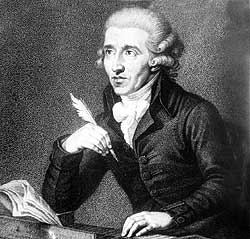
Portrait of Haydn,
by Ludwig Guttenbrunnen (1791) |
Haydn did not invent symphonic form, which grew out of the Baroque sinfonia, a fast-slow-fast single movement prologue to an opera or oratorio, to which a minuet was added from a divertimento or dance suite. The tripartite construction of the sinfonia also evolved into sonata form, the basic structure of symphonic opening movements, in which an exposition (itself consisting of three groups of initial, contrasting and closing themes) is then developed and recapitulated. Rather, Haydn perfected the symphony while investing it with character and even humor, which later composers would personalize and deepen.
The preeminent Haydn scholar H. C. Robbins Landon salutes that first Haydn symphony as impeccably crafted with a sure sense of form, although leading Haydn biographer Karl Geiringer dismisses it as light, playful and with nothing to point to future greatness. Indeed, heard today, it's unassuming yet sure-footed and utterly delightful. Yet, in one sense, it was of overwhelming importance – in the invited audience was Prince Paul of the Esterházy family, the oldest and wealthiest line of Hungarian nobility, who played the violin and cello and not only had a genuine love of music but could afford to indulge his passion. Soon after, when Morzin disbanded his orchestra, Prince Paul brought Haydn aboard as assistant kappellmeister to officiate at his lavish 200-room Eisenstadt castle. (Haydn was designated as assistant only out of respect for an aged semi-retired long-term predecessor, but essentially had full charge of all Esterházy musical activity from the very outset.) Paul died two years later in 1762 and was succeeded by Nicolas, an even greater music lover who built a second castle meant to rival Versailles, even including a sumptuous opera house.
Haydn would remain with the Esterházys through nearly the entire remainder of his life. At this juncture, it seems essential to understand the nature of that relationship. Geiringer notes that his first contract makes Haydn seem like a lowly servant – among other prescribed duties, he was to present himself twice daily to the Prince, who would then order the music he desired, to be performed in uniform "in white stockings, white linen, powdered and with either a queue or tie-wig." Indeed, the British press later carped that he was "immured in a place little better than a dungeon, subject to the domineering spirit of a petty Lord," that he lived "in a miserable apartment in a barracks furnished with nothing but a bed and an old spinet" and that his pay was less than the most obscure fiddler in London would accept. Yet, Geiringer cautions that the essential truth behind such exaggerations must be viewed in the context of the times – musicians had no chance of an independent career, all artists depended on the patronage of nobility, and Haydn basked in the glory of his prince, whose musical establishment was of unparalleled splendor and excellence. Indeed, Haydn's association with the Esterházys proved hugely beneficial, as it gave him ready access to the resources to realize his inspirations and to spread his growing fame throughout the continent.
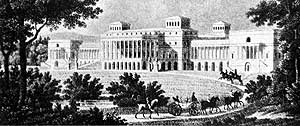
The Esterhazy castle at Eisenstadt |
Even though Haydn's contract stipulated that all his compositions would belong to the Prince, Geiringer notes that this provision was routinely ignored, and Haydn derived substantial income from selling his work to various publishers, which spread his fame yet further. However, in those days before copyright protection, pirated editions of popular composers' works were rampant. Thus, Haydn scholars often must establish which of several versions is the original, free of errors and emendations that crept into bootlegs. Haydn himself wasn't above occasional double- (or greater-) dealing – although Prince Ernst of Öttingen-Wallenstein paid handsomely for exclusive rights to three Haydn symphonies (#s 90 - 92 in the current numbering), Geiringer found that Haydn had also sent them to at least four publishers in Amsterdam, Paris and London.
Despite all his daily duties, ranging from routine diversion to complex operas, Haydn composed prolifically, turning out staggering numbers of works ranging from 160 trios for baryton (an awkward instrument, resembling a large viola with six bowed and 12 plucked strings, that Prince Nicolas loved to play) to a dozen full operas. Most remarkable of all were his symphonies. As analyzed by Landon and Geiringer, they may have begun as formulaic galant diversions and occasionally lapsed into pastiches of movements from other works, but developed slowly and surely. Under the influence of concerti, during the 1760s Haydn integrated solo elements and began to unify his work by deriving subsidiary themes from the main melody. Next came the "Sturm und Drang" ("Storm and Stress") period of 1766-74, when, in Landon's analysis, Haydn purged rococo superficiality in favor of a return to strict counterpoint, while hinting at romanticism by reflecting a wide range of mood, often in minor keys as a vehicle for turbulent thought. Geiringer adds that the influence of the "back to nature" movement of Rousseau and Goethe was reflected in unexpected ideas, bolder keys and a deepening of feeling. Throughout the 1780s, Haydn evolved his classical, balanced mature style, blending mannerism and emotion for a closer fit between ideas and form. Perhaps the high point of this period came in 1785, when Haydn fulfilled a commission from Comte d'Ogny for six symphonies for an enormous (for the time) orchestra, including 40 violins and ten basses, enabling him to explore the sheer sonic power afforded by such then-massive resources. (Now known as the "Paris" Symphonies, Haydn wasn't above selling them to each of three publishers.) All of these elements would find their way brilliantly and fluently into his final works in the genre.
Late in life, Haydn claimed to have enjoyed his tenure at Esterházy: "My prince was always satisfied with my works. Not only did I have the encouragement of constant approval, but as conductor of an orchestra I could make experiments, observe what produced an effect and what weakened it, and thus be in a position to improve, to alter, make additions or omissions and be as bold as I pleased."
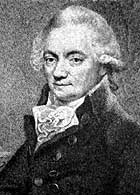
Johann Peter Salomon |
Haydn even credited his isolation from outside musical trends with the emergence of his originality. Yet by 1790, after 30 years of devoted service, Haydn may have been getting bored with his routine. That February he wrote: "Here I sit in my wilderness – abandoned – like a poor orphan – almost without human company." And again in July: "I am doomed to stay at home. … It is indeed sad to always be a slave. … I am a poor creature."
But out of misfortune and bondage comes opportunity and deliverance. On September 28, 1790, Prince Nicolas died. His son promptly dismissed most of the court musicians and relieved Haydn of his duties (although, to the Esterházys' credit, Haydn was kept on full salary). Haydn turned down offers of new court appointments, including one from the King of Naples, and went to Vienna. The news reached Johann Peter Salomon, a German violinist turned English impresario who was traveling to book new talent. He immediately went to Vienna to find Haydn. There, Salomon offered him 1,200 pounds to come to London with an opera, six symphonies and 20 lesser works to be given in concerts Haydn would direct. In one of the greatest coups in the history of promotion, Haydn accepted. He spent his last night in Vienna with his great friend Mozart, whom he recognized as the greatest musician of his time and from whom he had absorbed a certain degree of cosmopolitan influence. In what may be an apocryphal story, Mozart feared (accurately, as it would turn out) that they would never see each other again, pointed out that Haydn didn't speak a word of English and asked how he would manage in England, to which Haydn replied: "My language is understood all over the world."
 After an arduous two-week journey, Haydn and Salomon arrived in London on New Years Day, 1791. Having never before set foot outside Austria, the 58-year old composer was thrilled by the city's size and vitality, but repelled by its constant noise. Despite the barriers of language and culture, and fueled in equal part by his reputation and Solomon's huge publicity campaign, he was besieged with invitations and honors (including a doctorate from Oxford), hailed as a god of music, and received glowing notices. Haydn recalled his sojourn in England as the happiest time of his life. He stayed through the summer and the following year's concert season. After an arduous two-week journey, Haydn and Salomon arrived in London on New Years Day, 1791. Having never before set foot outside Austria, the 58-year old composer was thrilled by the city's size and vitality, but repelled by its constant noise. Despite the barriers of language and culture, and fueled in equal part by his reputation and Solomon's huge publicity campaign, he was besieged with invitations and honors (including a doctorate from Oxford), hailed as a god of music, and received glowing notices. Haydn recalled his sojourn in England as the happiest time of his life. He stayed through the summer and the following year's concert season.
In comparison, his homecoming to Vienna in July 1792 must have been a let-down. The next year he signed a new contract with Salomon and returned to London to present six further symphonies, this time accompanied by his copyist Johann Elssler (although he had wanted to bring along a new student, whom he greatly admired and hoped to promote – Ludwig van Beethoven; we can only wonder how the course of music might have changed had the young prodigy accepted!). There was no question about bringing a more logical companion – Haydn's wife, whom he had married in 1760. The elder sister of a woman he loved, she turned out to have none of the domestic qualities he sought and never appreciated his art. They lived mostly apart, she became jealous of his many affairs, and he referred to her as "that infernal beast."
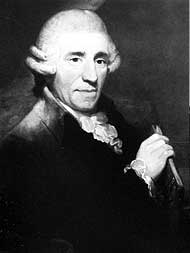
Portrait of Haydn,
by Thomas Hardy (1791) |
Haydn's second stay was as gratifying and successful as the first, not only professionally but romantically and financially – he fell in love with an English widow and his proceeds from a single benefit concert reportedly were more than twice his savings during his entire lifetime before coming to England. As the central figure in London's vibrant musical life – possibly the most highly developed in all of Europe at the time – he was invited by the King to remain and was offered a suite of rooms in Windsor Castle, but declined. Geiringer attributes the decision to Haydn's concern that he could not sustain the level of expectation or endure the pressure, as well as another reason – yet another Esterházy prince had assumed power and asked Haydn to return to restore the orchestra to its former greatness under his tenure, but with few demands beyond an annual mass to be written and performed on the princess's name-day. Out of loyalty and pride to those he had served at such length and with such devotion, Haydn accepted.
Just as Haydn sensibly never returned to the scene of his greatest triumph, nor did he ever write another symphony. Geiringer suggests that Haydn knew he had reached his peak in that genre and could progress no further. Instead, he turned his energies to masses and Die Schopfüng (The Creation) – arguably the capstone of his career, and the most acclaimed of all his works in his homeland.
Haydn's enduring achievement in London was the set of a dozen symphonies he wrote for Salomon's concerts. Each is an incontestable masterpiece. Taken together, they comprise one of the most sustained bursts of inspiration and lasting achievements in the annals of music. While firmly entrenched in the structure and reticent style of classicism, their experimental touches reflect a sense of fun, joy and adventure kindled by Haydn's freedom. The result impressed Harold Schonberg as a perfect fusion and balance of intellect and emotion, yet free of the neuroses that would drive his successors. Rather, the overall aura is one of well-adjusted wholesomeness and health. Paul Henry Lang attributes this to the intractable outlook of the Austrian peasant Haydn always remained, charged with a love of life, wit and the kaleidoscope of nature. As Alfred Einstein notes, Haydn was the most spontaneous of all composers. Bernard Jacobson adds that Haydn's ability to see clearly was undistorted by ego (indeed a rarity among artists of genius). Of course, none of this would have emerged from the confines of a castle nor survived strict formal training which Haydn fortunately was denied.
Commentators point to several traits in the London symphonies that paved the way for future evolution of the genre, while enabling Haydn to bring the form to a peak that has never been matched. Lang and Einstein both note Haydn's uncanny skill in inventing and selecting motifs and ideas that are especially suitable for development. 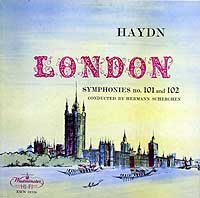 Indeed, Einstein credits the great discovery of Haydn's life as raising the middle development section of sonata form, previously a mere episode of melodic progression that soon returned home, to the core and focus of the movement. Geiringer goes on to credit Haydn with treating the final recapitulation section not as a mere mechanical repeat of the opening exposition, but as richly inspired as the development, and recasting the coda into a dramatic concentration of the thematic material. Add to all that a subtle relationship among the materials of the four movements, and the result, according to Einstein, is an unprecedented unity in which each part of the symphony seems like a different aspect of a single living organism, and thus lends the ending a sense of inevitability – a triumphant denouement and a joyous consummation of all that came before. Indeed, Einstein credits the great discovery of Haydn's life as raising the middle development section of sonata form, previously a mere episode of melodic progression that soon returned home, to the core and focus of the movement. Geiringer goes on to credit Haydn with treating the final recapitulation section not as a mere mechanical repeat of the opening exposition, but as richly inspired as the development, and recasting the coda into a dramatic concentration of the thematic material. Add to all that a subtle relationship among the materials of the four movements, and the result, according to Einstein, is an unprecedented unity in which each part of the symphony seems like a different aspect of a single living organism, and thus lends the ending a sense of inevitability – a triumphant denouement and a joyous consummation of all that came before.
Salomon's concerts gave Haydn the resources to display this culmination of his art. The hall seated 800 and the orchestra of 41, which Haydn conducted from the piano, was twice the size of the private band at Esterházy. The lengthy programs typically consisted of two parts. The first began with a symphony (by others), followed by concertos, arias and instrumental solos. The second opened with the first movement of a new Haydn symphony, then more concertos and solos, and concluded with the remainder of the new symphony. The reason for this seemingly peculiar configuration was a blend of showmanship and practicality. English audiences were noisy and inattentive and came to the concerts after dinner and drinks. As Haydn wrote: "The first act usually was disturbed in various ways by the noise of the latecomers. Not a few persons came from well-set tables (where the men, as is the custom of the country, stay in the dining room and drink after the ladies have left after the conclusion of the meal). They took a comfortable seat in the music room and were so gripped by the magic of the music that they fell fast asleep." William Mallock has suggested that Haydn's soft adagio introductions to all but one of his London symphonies were intended to settle the crowd down (much as the silent, opening credits of most movies nowadays dispels the din of all the coming attractions). Indeed, although Haydn denied it, many believe that the famous loud chord that suddenly shatters the quiet contentment of the adagio of the Symphony # 94 (now nicknamed the "Surprise") was meant to startle somnolent concertgoers. Murdock further submits that Haydn kept the audience attentive and on edge with the many fascinating "deceptions" with which he constantly enlivened his work and concluded with a loud chord to send his customers home satisfied.
 The most popular of all the twelve London symphonies was the one in G major, which received its premiere performance on March 31, 1794. (It is now known as Haydn's Symphony # 100 according to the compendium compiled by Eusebius Mandyczewski in 1907 which was remarkably complete, omitting only two youthful works, even though the chronology of the earlier works has been corrected by subsequent scholarship.) By tracing watermarks on the pages of the autograph score, Landon found that Haydn wrote the third of its four movements, a menuetto, in Vienna between his two London trips. The most popular of all the twelve London symphonies was the one in G major, which received its premiere performance on March 31, 1794. (It is now known as Haydn's Symphony # 100 according to the compendium compiled by Eusebius Mandyczewski in 1907 which was remarkably complete, omitting only two youthful works, even though the chronology of the earlier works has been corrected by subsequent scholarship.) By tracing watermarks on the pages of the autograph score, Landon found that Haydn wrote the third of its four movements, a menuetto, in Vienna between his two London trips.

The opening adagio theme |
The extraordinary second movement is an arrangement and elaboration of a concerto for two lira organizata (a sort of hurdy-gurdy) that Haydn had written in 1786 for the King of Naples. Haydn presumably wrote the outside movements between his second arrival in London on February 4 and the premiere.
Despite their disparate sources, all four movements form a remarkably cohesive whole. Their interrelationship is announced at the very outset in an amazingly dense and rich slow introduction – somber yet scored in high tessitura, with double-dotted rhythms to salute the past (as in a Baroque French overture), trilled notes to add a pervasive air of expectation, stops and rests to introduce the essential element of silence, a turn to the minor to foretell the forthcoming use of that mode to darken the next movement, and a persistent eighth-note rhythm to lend an overall sense of stylized propulsion.

The allegro flute theme of the first movement |
While this description sounds schematic, Haydn's genius is to meld these elements seamlessly and modestly. The movement proper, marked allegro, begins with a gesture that, perhaps more than any other, unifies and characterizes not only this work but all of the London symphonies – Haydn's extraordinary sense of musical humor. Among the hallmarks of Haydn's maturity was the increasing independence of his writing for woodwinds, previously often used merely to enrich the texture by doubling the strings. Here, he suddenly strips the opening sonority to assign his main melody to a screechy quartet of flutes and oboes straining at the very top of their ranges. Haydn then disrupts the pulse and adds harmonic surprises by ending the exposition with a full cadence and launching the development only after a full 2˝ bars of silence, dropping down a major third, and embarking on a series of bold harmonic excursions.
Despite the excellence of the first, it is the bold allegretto second movement that is unprecedented and unique in Haydn's output and that gave the symphony its vast appeal.

The simple theme of the allegretto |
A deceptively calm beginning features one of his simplistic, child-like tunes, even though the scoring is darkened by adding a pair of clarinets to the other movements' complement of strings and pairs of flutes, oboes, bassoons, trumpets and horns. Haydn then shatters the texture with a battery of "Turkish" percussion instruments, a novelty of the time already used literally by Mozart in his 1782 opera The Abduction from the Seraglio and to be followed fancifully by Beethoven in his 1824 Ninth Symphony. As described by historian Donald Francis Tovey, the apparatus consisted of a bass drum played with a big stick marking downbeats and a little stick keeping up a trotting rhythm, cymbals clashing in time with the big stick, and a triangle either ringing an alarum or trotting along with the little stick. Tovey further notes the curious duality of its use as sometimes tragic and sometimes triumphant. The Oxford Companion to Music adds a similarly bizarre twist to its definition – "expressive of warlike feeling or mere happy abandon."
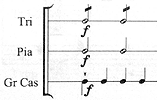
The "Turkish" music |
Karl Schumann suggests that Haydn managed to meld the two seemingly disparate evocations – the movement itself has no outward military character, marches or exotic melodies to accompany the Turkish instrumentation, and indeed has a dance-like lilt throughout, yet as the movement progresses its texture and harmony darken to add seriousness and repression to the light-hearted melody. Malloch agrees, calling the movement "tragical mirth," in which a pretend battle among toy soldiers changes to a real slaughter of real men in an unholy opposition.
Seemingly, at least one reviewer of the time agreed. The Morning Chronicle reported of an encore performance a week later: "It is the advancing to battle; and the march of men, the sounding of the charge, the thundering of the onset, the clash of arms, the groans of the wounded, and what may well be called the hellish roar of war increase to a climax of hellish sublimity." Heard today, with our knowledge of far more realistic depictions of war, it's hard to glean such raw emotion from Haydn's fundamentally sweet and heavily stylized music. Yet, within the context of its time, Haydn's sudden switch from C major to C minor at each onset of the Turkish percussion, a startling coda launched by a cold, insistent trumpet fanfare and a solo tympani roll, and the sheer volume of noise all must have made quite an impression. Indeed, while the work was first announced as a "New Grand Overture" (as were all Haydn's London symphonies), it was successively billed as "the Grand Overture with the Militaire Movement," the "Great Militaire Overture" and by July 1795, in both concert programs and Haydn's own diary, as the "Military Sinfonie," the title by which it is most commonly known today.
It was the remarkable second movement that launched the work's instant popularity. As the Morning Chronicle noted of that second performance (itself a rarity in an age that constantly demanded new works): "The middle movement again was received with absolute shouts of applause. Encore! encore! encore! resounded from every seat. The ladies themselves could not forbear."

The theme of the menuetto |
Typical of his dry wit, generations later Sir Thomas Beecham, arguably the greatest of all English conductors, had a simpler explanation of his compatriots' instant esteem for the Military Symphony: "The English do not like music, only the noise it makes."
The third menuetto movement is curious in its own right. David Johnson considers it an anachronism, a modest old-fashioned dance that stands apart from the typical minuets of the time, and that foreshadows the deeper undercurrents of Beethoven's scherzos. (Incidentally, although written with a grace note, the opening figure is played as a group of four sixteenths.) The presto finale is a whirlwind of constant extremes of quiet stretches and loud outbursts, constant motion and quirky pauses, but with three surprises within that dynamic context –

The theme of the presto finale |
Haydn cuts off the final measure of his theme to plunge into the first episode of his rondo/sonata structure, he replaces a regular recurrent soft pause with a startling burst of drums, and then just when the constant frenetic pace threatens to become wearying, he brings back the Turkish battery for a rousing final impact (this time leaving behind any hint of despair and decidedly displaying only the triumphant abandon of its dual nature).
 At least to judge from lists of early recordings, by the twentieth century affection for the Haydn symphonies had shifted from the "Military" to the "Surprise" (# 94), which boasted several sets of acoustic 78s, including the first Haydn on record in 1913 (by Eduard Künneke and the Odeon-Streichorchester), while a few of the others had only a smattering of releases. The Military had to await 1933 for its first complete recording by the Berlin Symphony Orchestra led by Hans Knappertsbusch, At least to judge from lists of early recordings, by the twentieth century affection for the Haydn symphonies had shifted from the "Military" to the "Surprise" (# 94), which boasted several sets of acoustic 78s, including the first Haydn on record in 1913 (by Eduard Künneke and the Odeon-Streichorchester), while a few of the others had only a smattering of releases. The Military had to await 1933 for its first complete recording by the Berlin Symphony Orchestra led by Hans Knappertsbusch,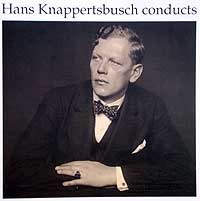 who had waxed the Surprise in 1929 with the Berlin State Opera Orchestra (and would record it twice more in 1941 and 1950 with the Berlin Philharmonic). (Two earlier ventures had been cut (by excising the opening adagio and trimming the allegretto) to fit each movement onto a single 12-inch 78 rpm side – a 1916 set by the Victor Concert Orchestra in extremely clear detail for the time, and a 1926 Vox set by an unnamed orchestra led by Erich Kleiber. Both are spirited yet graceful, with the Kleiber account, having the advantage of the new electrical recording technology, more full-bodied, with stronger dynamics and an especially pensive trio.) In contrast to his rather staid and unsurprising Surprises, as well as his straightforward Mozart recordings of similar vintage, Knappertsbush's Military is a fascinating document, marked by a creative and deeply personal interpretive touch – each movement is distended by a mammoth tempo shift at its mid-point, with varying impact. The first, following an extremely swift introduction and rather normal exposition nearly grinds to a halt for the far slower development, as if to signal with a change of pace the importance of Haydn's enlargement of that section's role within sonata form. (To further offset the development, Knappertsbusch inserts a long pause before the recapitulation, which then accelerates wildly to the coda.) Half-way through the allegretto, Knappertsbusch drops the tempo, as if to illustrate the dual nature of the Turkish music's evocation of war – both celebratory and then somber. Given a choice, Knappertsbush seems to favor the latter, as the treble portions of his Turkish music can barely be heard, and added pauses between phrases of the trumpet fanfare and slashing downbeats in the following measures all portend doubt and despair. That feeling is extended in the menuetto, whose spirited dance is brought to a standstill each of the three times the opening section is heard before picking up again. (An added curious touch – Knappertsbusch adds a repeat of the first section not in the score, perhaps in part to justify release on eight 78 rpm sides, rather than the six typically used for the work.) And to complete the scheme, Knappertsbusch literally halves the tempo at the mid-point of the finale. Whether viewed nowadays as daring and meaningful or merely quirky and frustrating, this remains not only the first, but the most quixotic, personal and stylistically challenging (and perhaps perplexing) Military on record (now on a Preiser CD). who had waxed the Surprise in 1929 with the Berlin State Opera Orchestra (and would record it twice more in 1941 and 1950 with the Berlin Philharmonic). (Two earlier ventures had been cut (by excising the opening adagio and trimming the allegretto) to fit each movement onto a single 12-inch 78 rpm side – a 1916 set by the Victor Concert Orchestra in extremely clear detail for the time, and a 1926 Vox set by an unnamed orchestra led by Erich Kleiber. Both are spirited yet graceful, with the Kleiber account, having the advantage of the new electrical recording technology, more full-bodied, with stronger dynamics and an especially pensive trio.) In contrast to his rather staid and unsurprising Surprises, as well as his straightforward Mozart recordings of similar vintage, Knappertsbush's Military is a fascinating document, marked by a creative and deeply personal interpretive touch – each movement is distended by a mammoth tempo shift at its mid-point, with varying impact. The first, following an extremely swift introduction and rather normal exposition nearly grinds to a halt for the far slower development, as if to signal with a change of pace the importance of Haydn's enlargement of that section's role within sonata form. (To further offset the development, Knappertsbusch inserts a long pause before the recapitulation, which then accelerates wildly to the coda.) Half-way through the allegretto, Knappertsbusch drops the tempo, as if to illustrate the dual nature of the Turkish music's evocation of war – both celebratory and then somber. Given a choice, Knappertsbush seems to favor the latter, as the treble portions of his Turkish music can barely be heard, and added pauses between phrases of the trumpet fanfare and slashing downbeats in the following measures all portend doubt and despair. That feeling is extended in the menuetto, whose spirited dance is brought to a standstill each of the three times the opening section is heard before picking up again. (An added curious touch – Knappertsbusch adds a repeat of the first section not in the score, perhaps in part to justify release on eight 78 rpm sides, rather than the six typically used for the work.) And to complete the scheme, Knappertsbusch literally halves the tempo at the mid-point of the finale. Whether viewed nowadays as daring and meaningful or merely quirky and frustrating, this remains not only the first, but the most quixotic, personal and stylistically challenging (and perhaps perplexing) Military on record (now on a Preiser CD).
The next Military could not have been more dissimilar. 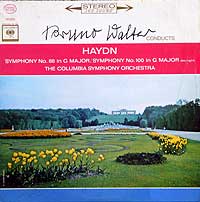 In a 1938 recording with the Vienna Philharmonic (although judging from the sound, an audibly stripped-down version of the full ensemble), Bruno Walter is thoroughly gentle, with moderate tempos, careful inflection and barely a hint of drama. Like in its predecessor, the Turkish instruments are barely audible and the extra measure between the allegro exposition repeat and development is omitted, although in both cases this occurs over a side change and could just be an artifact of an ignorant engineer effecting a side join for CD transfer (but in any event would never have been noticed during the ten-plus seconds needed to switch sides in the original 78 rpm format). Walter's allegretto suggests none of the duality of Knappertsbusch, but rather coasts along contentedly without any changes of texture, its trumpet call strictly in tempo and its tympani roll polite and wilting. Indeed, the entire allegretto is eclipsed by a far more vivid and somewhat more yielding menuetto. Frankly, compared to his other Haydn recordings of the time (Symphonies 86, 92 and 96), his Military emerges as rather bland. If this sounds like one of the warm, autumnal performances that Walter was more likely to render during his final years, then here's the ultimate surprise – he rerecorded the Military in stereo with the Columbia Symphony in 1961 (Columbia LP, Sony CD) with far more relaxed pacing, flexible tempos, crisper phrasing and even Viennese grace with his American orchestra than with the genuine Viennese one! In a 1938 recording with the Vienna Philharmonic (although judging from the sound, an audibly stripped-down version of the full ensemble), Bruno Walter is thoroughly gentle, with moderate tempos, careful inflection and barely a hint of drama. Like in its predecessor, the Turkish instruments are barely audible and the extra measure between the allegro exposition repeat and development is omitted, although in both cases this occurs over a side change and could just be an artifact of an ignorant engineer effecting a side join for CD transfer (but in any event would never have been noticed during the ten-plus seconds needed to switch sides in the original 78 rpm format). Walter's allegretto suggests none of the duality of Knappertsbusch, but rather coasts along contentedly without any changes of texture, its trumpet call strictly in tempo and its tympani roll polite and wilting. Indeed, the entire allegretto is eclipsed by a far more vivid and somewhat more yielding menuetto. Frankly, compared to his other Haydn recordings of the time (Symphonies 86, 92 and 96), his Military emerges as rather bland. If this sounds like one of the warm, autumnal performances that Walter was more likely to render during his final years, then here's the ultimate surprise – he rerecorded the Military in stereo with the Columbia Symphony in 1961 (Columbia LP, Sony CD) with far more relaxed pacing, flexible tempos, crisper phrasing and even Viennese grace with his American orchestra than with the genuine Viennese one!
In his highly opinionated 1941 pioneering Guide to Recorded Music (Doubleday), Irving Kolodin disparaged both of the only then-available recordings of the Military, citing the "flaccid character of Walter's interpretation and its prevailing lack of force," which he still found "more attractive than the heavy, unimaginative performance of Knappertsbusch." While his critique of the Walter is valid, it's hard to understand his disdain for the vibrant invention of Knappertsbusch's approach, abetted by scrappy but lively playing, and complete with a touch of portamento (sliding between notes) as a backward glance at the romantic style that Haydn only foretold and subsequent recordings would leave behind as an inappropriate relic. In any event, Kolodin's frustration would have to fester for another decade while awaiting the next potent contender.
Hermann Scherchen broke the logjam in spectacular style by recording not only the Military but the first complete set of London symphonies for the fledgling and ambitious Westminster label. 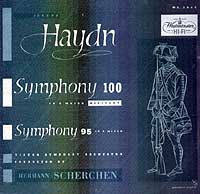 Scherchen is best remembered for his pioneering work with modern music, but he was just as devoted to concerts and broadcasts of pre-classical music, a small sample of which he preserved in his 1961 series of Birth of the Symphony LPs (now on Tahra CDs). In program notes, Scherchen had cited an earlier author's insistence upon "fire and soul" to bring expression to the written score, and that's just what he brought to his 1950 Military with the Vienna Symphony Orchestra, which boasted an interpretive touch nearly as bold as Knappertsbusch – Scherchen's reading of fundamental dignity and muscular strength (while shorn of all humor) is galvanized not only by startlingly vivid Turkish music but by hugely emphatic tympani, whose aural impact was swelled by distortion in the original pressings. Indeed, the work gains a curious power through this very contrast between classical control and relaxed, staid pacing that is constantly challenged by the coiled tension of those commanding drums. To add to his role as a pioneer, Scherchen appears to be the only conductor to have recorded the Military not only twice (itself a rarity) but three times – and all within the span of a mere decade. Scherchen is best remembered for his pioneering work with modern music, but he was just as devoted to concerts and broadcasts of pre-classical music, a small sample of which he preserved in his 1961 series of Birth of the Symphony LPs (now on Tahra CDs). In program notes, Scherchen had cited an earlier author's insistence upon "fire and soul" to bring expression to the written score, and that's just what he brought to his 1950 Military with the Vienna Symphony Orchestra, which boasted an interpretive touch nearly as bold as Knappertsbusch – Scherchen's reading of fundamental dignity and muscular strength (while shorn of all humor) is galvanized not only by startlingly vivid Turkish music but by hugely emphatic tympani, whose aural impact was swelled by distortion in the original pressings. Indeed, the work gains a curious power through this very contrast between classical control and relaxed, staid pacing that is constantly challenged by the coiled tension of those commanding drums. To add to his role as a pioneer, Scherchen appears to be the only conductor to have recorded the Military not only twice (itself a rarity) but three times – and all within the span of a mere decade. 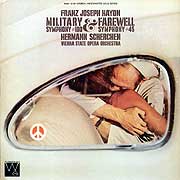 Perhaps to compensate for the dull sonic quality of his 1950 recording, a 1954 remake with the Royal Philharmonic (identified as the "Philharmonic Symphony Orchestra of London") was released on Westminster's LAB series which boasted innovative high fidelity (and sprawled the 24-minute work over both sides under pretext, as the liner notes assured, that a limitation of 17 minutes was necessary for "the complete elimination of mechanical distortion and echo and the one hundred percent faithful reproduction of the clarity and full dynamic range of the recorded sound"). Heard today, it still sounds quite good, but so do most other recordings of the late mono LP era. Scherchen's final remake was a 1958 stereo release, again with the Vienna Symphony. To the features of the earlier ventures, he adds two more – having the trumpet fanfare march from right to left speakers, and an astoundingly brisk finale of well under 4 minutes, including repeats. (His 1950 finale clocks in at a more typical 5:10.) While the first effect seems gimmicky, the latter is brilliantly effective – not only does the orchestra pass this articulation and endurance test with flying colors (although one splice seems evident at 2:18), but the combination of reckless propulsion and elegant grace is truly thrilling, even though at such speed some details of Haydn's structure tend to pass by too quickly to fully register. To top off his feat, Scherchen ends his romp with a huge extra dollop of energy. We should note that much of the Scherchen catalog was marketed on the budget Westminster Gold series to reach a new generation through graphics that were catchy but often of dubious taste, although a reissue of the Military combined an inference of its title with that of its disc-mate, the Symphony # 45 ("Farewell") for a photo that perhaps reflects Haydn's own quirky humor. Perhaps to compensate for the dull sonic quality of his 1950 recording, a 1954 remake with the Royal Philharmonic (identified as the "Philharmonic Symphony Orchestra of London") was released on Westminster's LAB series which boasted innovative high fidelity (and sprawled the 24-minute work over both sides under pretext, as the liner notes assured, that a limitation of 17 minutes was necessary for "the complete elimination of mechanical distortion and echo and the one hundred percent faithful reproduction of the clarity and full dynamic range of the recorded sound"). Heard today, it still sounds quite good, but so do most other recordings of the late mono LP era. Scherchen's final remake was a 1958 stereo release, again with the Vienna Symphony. To the features of the earlier ventures, he adds two more – having the trumpet fanfare march from right to left speakers, and an astoundingly brisk finale of well under 4 minutes, including repeats. (His 1950 finale clocks in at a more typical 5:10.) While the first effect seems gimmicky, the latter is brilliantly effective – not only does the orchestra pass this articulation and endurance test with flying colors (although one splice seems evident at 2:18), but the combination of reckless propulsion and elegant grace is truly thrilling, even though at such speed some details of Haydn's structure tend to pass by too quickly to fully register. To top off his feat, Scherchen ends his romp with a huge extra dollop of energy. We should note that much of the Scherchen catalog was marketed on the budget Westminster Gold series to reach a new generation through graphics that were catchy but often of dubious taste, although a reissue of the Military combined an inference of its title with that of its disc-mate, the Symphony # 45 ("Farewell") for a photo that perhaps reflects Haydn's own quirky humor.
One more historical performance comes not from a record as such but rather a 1956 concert broadcast performance by Dimitri Mitropoulos and the New York Philharmonic (AS Disc), distinguished by two neat tricks. Their introductory adagio is taken at such a slow tempo (2:40, as compared to a typical 1:40 or so) that the remainder of the movement, although normally paced, seems fast without any need to actually rush through it. In contrast to the string-heavy balance of all prior recordings, Mitropoulos's second movement is dominated by the high winds (and, like the others, underplays the Turkish battery), thus accentuating a feeling for the mock "toy soldier" aspect of the work.
 I have somewhat arbitrarily divided the other recordings of the Military that I've heard into three categories. The first utilizes full orchestras, modern instruments and pitch, and exhibits little pretense of period style. Let Joseph McLellan of the Washington Post raise a cogent defense of that approach (assuming justification is needed): I have somewhat arbitrarily divided the other recordings of the Military that I've heard into three categories. The first utilizes full orchestras, modern instruments and pitch, and exhibits little pretense of period style. Let Joseph McLellan of the Washington Post raise a cogent defense of that approach (assuming justification is needed):
The important point about Haydn's music – much more significant than … whether you use old or modern instruments and whether you tune your A to 415 or 440 – is whether you convey the music's pure sense of fun and its sudden, unexpected depths. Yes, it is wonderful to hear old music on gut strings and valveless horns and to imagine that we are hearing the exact sounds imagined by the composer. … But historical piety and scholarly tidiness can easily make us forget that we are dealing here with the basic stuff of human life, joys and passions, distilled into forms that can last for centuries and be shared with all humanity.
Another point worth remembering is the observation of Christopher Hogwood that the notion of "authentic" performance goes well beyond simple reliance upon the composer's autograph score, since that source merely represents his thoughts prior to rehearsals and performances when many significant adjustments could have been made. Rather, the most reliable guides could be the conductor's score and even later editions (but before unauthorized changes wrought by latter-day editors).
The advent of the LP should have boosted the fortunes of the Haydn symphonies – each was a natural fit on a single 33 rpm side and two paired together made a sensible album. 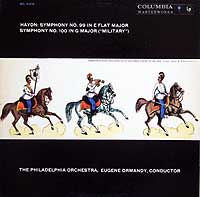 Yet surprisingly few appeared in the decade before stereo. Indeed, the next Military I've encountered was a hold-over. Although released in 1958, well into the stereo era, a version by Eugene Ormandy and the Philadelphia Orchestra appears to have been issued only in mono. Even so, it set the pace for many recordings to follow that place Haydn squarely within the sonic context of the next century rather than his own time and resources. Notwithstanding his reputation as a reliable but unexciting conductor, Ormandy leads a beautifully smooth and polished yet spirited reading with straight-forward playing, as if to flaunt the famed virtuosity of his orchestra, exuding an air of self-confidence, shorn of any need for ostentation. Yet in two respects the Ormandy reading serves as a solid introduction to the overall practice of treating Haydn alongside masters of succeeding generations. First, Ormandy adds a few expressive touches that go beyond the score, including some romantic phrasing by slowing the tempo of the menuetto as the volume drops at the end of a phrase. Second, he freely revises the notations of the score, as when he has the strings play notes pizzicato (plucked) rather than arco (bowed) at measures 79 and 122 of the finale. More significant, Ormandy appears to have been the first conductor on record to change the indications for the Turkish group. For most of those passages, the score (as shown in the preceding section) clearly indicates that for each four-beat bar the cymbals are to sound twice, the bass drum four times and the triangle eight, but Ormandy omits all but the first cymbal stroke in each bar. The result is to reduce the clamor called for by Haydn's more frequent use of the cymbals, while shifting the orchestration toward the more common romantic use of cymbals to accentuate downbeats. Many other conductors would effect similar adjustments, ranging from paring the drum notes to adding soft triangle accents to a woodwind passage beginning at bar 121 of the allegretto. Yet surprisingly few appeared in the decade before stereo. Indeed, the next Military I've encountered was a hold-over. Although released in 1958, well into the stereo era, a version by Eugene Ormandy and the Philadelphia Orchestra appears to have been issued only in mono. Even so, it set the pace for many recordings to follow that place Haydn squarely within the sonic context of the next century rather than his own time and resources. Notwithstanding his reputation as a reliable but unexciting conductor, Ormandy leads a beautifully smooth and polished yet spirited reading with straight-forward playing, as if to flaunt the famed virtuosity of his orchestra, exuding an air of self-confidence, shorn of any need for ostentation. Yet in two respects the Ormandy reading serves as a solid introduction to the overall practice of treating Haydn alongside masters of succeeding generations. First, Ormandy adds a few expressive touches that go beyond the score, including some romantic phrasing by slowing the tempo of the menuetto as the volume drops at the end of a phrase. Second, he freely revises the notations of the score, as when he has the strings play notes pizzicato (plucked) rather than arco (bowed) at measures 79 and 122 of the finale. More significant, Ormandy appears to have been the first conductor on record to change the indications for the Turkish group. For most of those passages, the score (as shown in the preceding section) clearly indicates that for each four-beat bar the cymbals are to sound twice, the bass drum four times and the triangle eight, but Ormandy omits all but the first cymbal stroke in each bar. The result is to reduce the clamor called for by Haydn's more frequent use of the cymbals, while shifting the orchestration toward the more common romantic use of cymbals to accentuate downbeats. Many other conductors would effect similar adjustments, ranging from paring the drum notes to adding soft triangle accents to a woodwind passage beginning at bar 121 of the allegretto.
The most acclaimed set of the full London symphonies came from Sir Thomas Beecham toward the end of his long career. When compared to others, at first they may seem unengaged and disappointing, but in fact Beecham presents a mature view of works that, after all, were written by a mature composer. His 1958 Military with the Royal Philharmonic (one of the several orchestras he founded) belies the occasional criticism that Beecham emasculates Haydn. It is true that his allegretto flies by in less than five minutes, has inaudible drums, is drained of any hint of gravity and seems more like a gracious dance than an evocation of war. Yet Beecham's interest lay elsewhere. James Harding recalled the Military that Beecham included in his last concert in May 1960 as evoking "to perfection Haydn's delicate colouring, eloquence and wit." Indeed, to those qualities can be added an aura of inner peace and contentment, of being unabashedly happy, free and without any conflict. While others have mined many veiled riches in Haydn's late symphonies, Beecham conveys a wonderful sense of balance and abstract artistry that focuses wholly upon the music. The only small liberty he takes is to add a surge of volume to the end of each movement, although Haydn, ever the populist, himself reportedly endorsed this, so as to give his audience a happy finish. The only drawback is the thin, bass-deficient sound which, despite heroic efforts at sonic refurbishment for the latest CD incarnation, still has little quality or character. (Beecham had recorded several Haydn symphonies in the 1930s for Columbia with his new London Symphony Orchestra, but not the Military.) came from Sir Thomas Beecham toward the end of his long career. When compared to others, at first they may seem unengaged and disappointing, but in fact Beecham presents a mature view of works that, after all, were written by a mature composer. His 1958 Military with the Royal Philharmonic (one of the several orchestras he founded) belies the occasional criticism that Beecham emasculates Haydn. It is true that his allegretto flies by in less than five minutes, has inaudible drums, is drained of any hint of gravity and seems more like a gracious dance than an evocation of war. Yet Beecham's interest lay elsewhere. James Harding recalled the Military that Beecham included in his last concert in May 1960 as evoking "to perfection Haydn's delicate colouring, eloquence and wit." Indeed, to those qualities can be added an aura of inner peace and contentment, of being unabashedly happy, free and without any conflict. While others have mined many veiled riches in Haydn's late symphonies, Beecham conveys a wonderful sense of balance and abstract artistry that focuses wholly upon the music. The only small liberty he takes is to add a surge of volume to the end of each movement, although Haydn, ever the populist, himself reportedly endorsed this, so as to give his audience a happy finish. The only drawback is the thin, bass-deficient sound which, despite heroic efforts at sonic refurbishment for the latest CD incarnation, still has little quality or character. (Beecham had recorded several Haydn symphonies in the 1930s for Columbia with his new London Symphony Orchestra, but not the Military.)
Another much-admired set of the Londons from an eminent British conductor was cut by Colin Davis, albeit leading the Concertgebouw Orchestra of Amsterdam rather than one of the English or American orchestras with which he often was associated (Philips, 1977). (The CD cover is nearly identical to that of the LP, with one exception – the conductor is named Sir Colin Davis, reflecting his 1980 knighthood.) Known for his emotional reserve and attention to detail, especially in his Berlioz cycles, Davis provides a surprisingly weighty and opulent reading of the Military, with just a hint of flexibility to vary his moderate tempos and an occasional rhythmic bounce to leaven the bass-heavy depth and thick textures. Thus, Davis presents an unusual view of a work often hailed for its humor and shifting moods, as he underlines the work's profundity, deepened yet further by the allegretto's resounding bass drum (played in authentic fashion with palpable back-beat drum strokes). Even the fanfare and tympani roll seem bland, unwilling to shift gears from the prevailing gravity. The overall impression is of a severe, somewhat dour work, more in keeping with the companion Symphony # 104 and perhaps looking forward to the philosophical outlook of the century that would follow. was cut by Colin Davis, albeit leading the Concertgebouw Orchestra of Amsterdam rather than one of the English or American orchestras with which he often was associated (Philips, 1977). (The CD cover is nearly identical to that of the LP, with one exception – the conductor is named Sir Colin Davis, reflecting his 1980 knighthood.) Known for his emotional reserve and attention to detail, especially in his Berlioz cycles, Davis provides a surprisingly weighty and opulent reading of the Military, with just a hint of flexibility to vary his moderate tempos and an occasional rhythmic bounce to leaven the bass-heavy depth and thick textures. Thus, Davis presents an unusual view of a work often hailed for its humor and shifting moods, as he underlines the work's profundity, deepened yet further by the allegretto's resounding bass drum (played in authentic fashion with palpable back-beat drum strokes). Even the fanfare and tympani roll seem bland, unwilling to shift gears from the prevailing gravity. The overall impression is of a severe, somewhat dour work, more in keeping with the companion Symphony # 104 and perhaps looking forward to the philosophical outlook of the century that would follow.
Leonard Bernstein programmed most of the late Haydn symphonies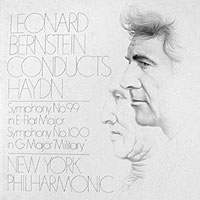 during his tenure with the New York Philharmonic and won a rare plaudit – no less an authority than Landon anointed him one of the greatest Haydn conductors of all time. His universally acclaimed set of the six "Paris" symphonies (#s 82 – 87) bursts with an energy largely muted in his 1970 Military (Columbia LP, Sony CD). After a promising start of a delicately phrased introduction, the rest devolves into a routine rendition, yet strong, virile and assured. The allegretto is uncommonly warm, but its drum roll is notably weak, perhaps intended to reflect Bernstein's pacifist outlook. Yet, the curious balance boosts the generally overlooked trumpet part to unnatural levels, suggesting a heightened martial character, and adding to the piece a novel perspective for those enamored of that instrument but otherwise disrupting the accustomed sonic blend, an anomaly not heard in Bernstein's other Haydn recordings of the same period. As if to assert his personality, if only at the very end, Bernstein continues the triangle through the last two measures, although the score (and all other recordings) conclude with single triangle strokes only on the downbeats. during his tenure with the New York Philharmonic and won a rare plaudit – no less an authority than Landon anointed him one of the greatest Haydn conductors of all time. His universally acclaimed set of the six "Paris" symphonies (#s 82 – 87) bursts with an energy largely muted in his 1970 Military (Columbia LP, Sony CD). After a promising start of a delicately phrased introduction, the rest devolves into a routine rendition, yet strong, virile and assured. The allegretto is uncommonly warm, but its drum roll is notably weak, perhaps intended to reflect Bernstein's pacifist outlook. Yet, the curious balance boosts the generally overlooked trumpet part to unnatural levels, suggesting a heightened martial character, and adding to the piece a novel perspective for those enamored of that instrument but otherwise disrupting the accustomed sonic blend, an anomaly not heard in Bernstein's other Haydn recordings of the same period. As if to assert his personality, if only at the very end, Bernstein continues the triangle through the last two measures, although the score (and all other recordings) conclude with single triangle strokes only on the downbeats.
In notes to his integral LP set,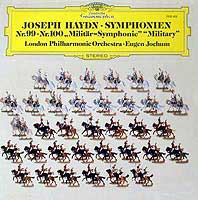 Eugen Jochum commented that he wanted to play and record Haydn's London symphonies in the city where they were written, for which they were intended and where they received their premieres. He proceeded to lead all of them in a series of four concerts of which they comprised the entire program and then to record them with the London Philharmonic (another of Beecham's orchestras) (DG, 1975). Notwithstanding the sincerity of his intentions, it's unclear how an unrelated orchestra and a city that had vastly evolved two centuries later truly connect to the composer's original conceptions. At any rate Jochum's feat had been trumped by Beecham, Klemperer and Jones, who already had recorded the Londons with London ensembles. In any event, his fleet tempos and nimble execution belie the large orchestral texture to produce a satisfying, if unspectacular, set, including a solid Military. Eugen Jochum commented that he wanted to play and record Haydn's London symphonies in the city where they were written, for which they were intended and where they received their premieres. He proceeded to lead all of them in a series of four concerts of which they comprised the entire program and then to record them with the London Philharmonic (another of Beecham's orchestras) (DG, 1975). Notwithstanding the sincerity of his intentions, it's unclear how an unrelated orchestra and a city that had vastly evolved two centuries later truly connect to the composer's original conceptions. At any rate Jochum's feat had been trumped by Beecham, Klemperer and Jones, who already had recorded the Londons with London ensembles. In any event, his fleet tempos and nimble execution belie the large orchestral texture to produce a satisfying, if unspectacular, set, including a solid Military.
A curiosity of sorts came from Leslie Jones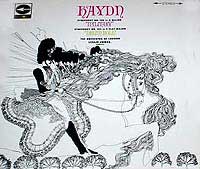 and the Orchestra of London, who cut not only the entire London set but many of the more obscure Haydn symphonies for Nonesuch, in keeping with that fine budget label's sense of adventurous repertoire. Their Military, separately released on Checkpoint, featured a striking cover drawn by Bob Pepper, and is generally slow, dignified and gentle, but adds a unique feature of a harpsichord continuo. Most of Haydn's earlier symphonies assumed that the leader would improvise an accompaniment from the keyboard, and indeed, when Haydn presented his London symphonies he reportedly sat at a centrally-positioned piano (rather than a sonically more conspicuous harpsichord) while Salomon led from the front. Yet, commentators have noted that while most of his earlier works needed a continuo to flesh out the harmony, the richer orchestration of the London set does not. In any event, Jones' harpsichord doesn't embellish or otherwise command attention but rather sticks to downbeat chords and is barely evident, even in the softest passages. Among other recordings, only those that strive for historical accuracy have this presumably authentic touch, although they opt for the more mellow sound of the fortepiano. and the Orchestra of London, who cut not only the entire London set but many of the more obscure Haydn symphonies for Nonesuch, in keeping with that fine budget label's sense of adventurous repertoire. Their Military, separately released on Checkpoint, featured a striking cover drawn by Bob Pepper, and is generally slow, dignified and gentle, but adds a unique feature of a harpsichord continuo. Most of Haydn's earlier symphonies assumed that the leader would improvise an accompaniment from the keyboard, and indeed, when Haydn presented his London symphonies he reportedly sat at a centrally-positioned piano (rather than a sonically more conspicuous harpsichord) while Salomon led from the front. Yet, commentators have noted that while most of his earlier works needed a continuo to flesh out the harmony, the richer orchestration of the London set does not. In any event, Jones' harpsichord doesn't embellish or otherwise command attention but rather sticks to downbeat chords and is barely evident, even in the softest passages. Among other recordings, only those that strive for historical accuracy have this presumably authentic touch, although they opt for the more mellow sound of the fortepiano.
Two sets 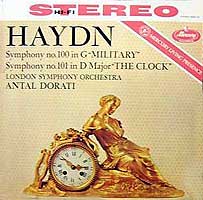 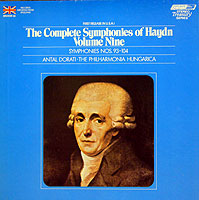 merit special mention and hallowed places in the history of Haydn symphony recordings for comprising the first full cycles. An earlier attempt had been launched by New Yorker Max Goberman in 1960 with the Vienna State Opera Orchestra for his own subscription label, the Library of Recorded Masterpieces, but was halted upon his death two years later, short of reaching the mid-point. Initial volumes boasted deluxe gatefold formats with copious notes by Landon and inserts of the complete scores; the first 22 symphonies were reissued in 1966 on the budget Odyssey label in eight volumes with abbreviated Landon notes. With the Philharmonia Hungarica, Antal Dorati recorded not only all 104 Haydn symphonies in the official canon, but two later discoveries, alternate versions and 24 extra minuets, all released in the early 1970s in four- and six-LP box sets on the budget London Stereo Treasury label with thorough (although cheaply printed) notes by Landon. While his premiere performances of some less-known symphonies were revelatory, Dorati held his own in the more popular ones, to which he adds several distinctive touches which, while seemingly anomalous in less experienced hands, carry the authoritative weight of his familiarity with the entire Haydn oeuvre. Thus, his Military concludes the opening adagio with a suspenseful held note before launching into the ensuing allegro, carefully distinguishes between the two sticks playing the bass drum in the Turkish ensemble, emphasizes the emotional shift in the allegretto with an especially brazen trumpet fanfare, softens the menuetto by shaping each eighth-note run to end on a whisper, and adds variety to the finale by hushing the exposition repeat. (Previously, Dorati had recorded the Military in 1957 with the London Symphony for Mercury in a more pointed reading, including a wildly rapid finale.) Although largely swamped by London’s marketing clout and thus bypassed by most collectors, Dorati’s set had been preceded by another full set: nearly four dozen individual albums, released by the Musical Heritage Society mostly in 1970, from the Vienna Chamber Orchestra led by Ernst Maerzendorfer, a rather surprising choice, as his reputation arose from opera. His Military is generally relaxed aside from a swift allegretto that benefits from prominent winds that effectively offset the strong tutti outburst near the end, and with the outer movements (but, curiously, not the militaristic allegretto) fueled by especially insistent tympani. merit special mention and hallowed places in the history of Haydn symphony recordings for comprising the first full cycles. An earlier attempt had been launched by New Yorker Max Goberman in 1960 with the Vienna State Opera Orchestra for his own subscription label, the Library of Recorded Masterpieces, but was halted upon his death two years later, short of reaching the mid-point. Initial volumes boasted deluxe gatefold formats with copious notes by Landon and inserts of the complete scores; the first 22 symphonies were reissued in 1966 on the budget Odyssey label in eight volumes with abbreviated Landon notes. With the Philharmonia Hungarica, Antal Dorati recorded not only all 104 Haydn symphonies in the official canon, but two later discoveries, alternate versions and 24 extra minuets, all released in the early 1970s in four- and six-LP box sets on the budget London Stereo Treasury label with thorough (although cheaply printed) notes by Landon. While his premiere performances of some less-known symphonies were revelatory, Dorati held his own in the more popular ones, to which he adds several distinctive touches which, while seemingly anomalous in less experienced hands, carry the authoritative weight of his familiarity with the entire Haydn oeuvre. Thus, his Military concludes the opening adagio with a suspenseful held note before launching into the ensuing allegro, carefully distinguishes between the two sticks playing the bass drum in the Turkish ensemble, emphasizes the emotional shift in the allegretto with an especially brazen trumpet fanfare, softens the menuetto by shaping each eighth-note run to end on a whisper, and adds variety to the finale by hushing the exposition repeat. (Previously, Dorati had recorded the Military in 1957 with the London Symphony for Mercury in a more pointed reading, including a wildly rapid finale.) Although largely swamped by London’s marketing clout and thus bypassed by most collectors, Dorati’s set had been preceded by another full set: nearly four dozen individual albums, released by the Musical Heritage Society mostly in 1970, from the Vienna Chamber Orchestra led by Ernst Maerzendorfer, a rather surprising choice, as his reputation arose from opera. His Military is generally relaxed aside from a swift allegretto that benefits from prominent winds that effectively offset the strong tutti outburst near the end, and with the outer movements (but, curiously, not the militaristic allegretto) fueled by especially insistent tympani.
Three conductors provide an antidote to others' personal interpretive touches.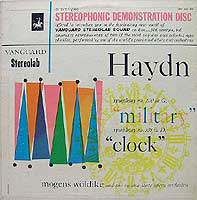 One, predictably, is Otto Klemperer. His 1966 Military with the Philharmonia Orchestra is as uninflected as possible – serious, deliberate and steadfast yet never grim or severe. Even shorn of any rhetoric, Haydn's own humor and surprises emerge quite well, thus serving to testify to the quality of his conception and natural skill. While the sound unmistakably is that of a full, deep modern orchestra, from the prominent bass to the strident triangle, Klemperer's seating plan that spreads the first and second violin sections across the entire front of the soundstage lends an open, airy quality that avoids any sense of stifling thickness inimical to the music. One, predictably, is Otto Klemperer. His 1966 Military with the Philharmonia Orchestra is as uninflected as possible – serious, deliberate and steadfast yet never grim or severe. Even shorn of any rhetoric, Haydn's own humor and surprises emerge quite well, thus serving to testify to the quality of his conception and natural skill. While the sound unmistakably is that of a full, deep modern orchestra, from the prominent bass to the strident triangle, Klemperer's seating plan that spreads the first and second violin sections across the entire front of the soundstage lends an open, airy quality that avoids any sense of stifling thickness inimical to the music. 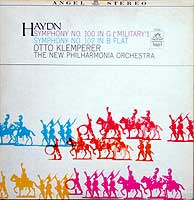 Georg Solti's 1983 Military, part of a complete set of Londons with the London Philharmonic, boasts excellent playing and a richly detailed recording that highlights the prominent backbeat of his Turkish bass drum and is otherwise free of the questionable yet effective dramatic quirks in some of the others. Thus, his "Surprise," with which it shares a single disc release, has exaggerated dynamics to highlight the famous startling chord and heightens the sense of a leisurely andante by drawing out the ends of each phrase. The third conductor is Mogens Woldike, also born in the nineteenth century, who led the Vienna State Opera Orchestra (the farm team for the Vienna Philharmonic) in superb, finely balanced 1956 stereo readings of the second six London symphonies (Vanguard) that boast a superb sense of style – tempos are all just right, phrasing enthused, execution precise, textures lean, balances ideal. Like Klemperer, Woldike is direct and thoroughly musical and his recording superb, but in addition, as a relative unknown outside Denmark, his recordings may be said to have paved the way for other conductors to apply their own skill to compete in the Haydn arena. And when all is said and done, despite all the effusive poetic literary descriptions of music at the time, the composers themselves all seem to have emphasized above all the importance of a steady beat and precise articulation. So perhaps this plain unadorned approach is just what Haydn himself would have wanted – and undoubtedly he would have been thrilled with the rich, full-bodied sound and superb playing of orchestras far beyond anything he had heard in his own time. Georg Solti's 1983 Military, part of a complete set of Londons with the London Philharmonic, boasts excellent playing and a richly detailed recording that highlights the prominent backbeat of his Turkish bass drum and is otherwise free of the questionable yet effective dramatic quirks in some of the others. Thus, his "Surprise," with which it shares a single disc release, has exaggerated dynamics to highlight the famous startling chord and heightens the sense of a leisurely andante by drawing out the ends of each phrase. The third conductor is Mogens Woldike, also born in the nineteenth century, who led the Vienna State Opera Orchestra (the farm team for the Vienna Philharmonic) in superb, finely balanced 1956 stereo readings of the second six London symphonies (Vanguard) that boast a superb sense of style – tempos are all just right, phrasing enthused, execution precise, textures lean, balances ideal. Like Klemperer, Woldike is direct and thoroughly musical and his recording superb, but in addition, as a relative unknown outside Denmark, his recordings may be said to have paved the way for other conductors to apply their own skill to compete in the Haydn arena. And when all is said and done, despite all the effusive poetic literary descriptions of music at the time, the composers themselves all seem to have emphasized above all the importance of a steady beat and precise articulation. So perhaps this plain unadorned approach is just what Haydn himself would have wanted – and undoubtedly he would have been thrilled with the rich, full-bodied sound and superb playing of orchestras far beyond anything he had heard in his own time.
 In this next group I'm placing recordings with modern instruments but informed by historical performance practices in varying degrees. In all candor, the interpretive and sonic differences between these and those in the final group are barely perceptible, so the distinction often is a matter of resources rather than meaningful aesthetics. In this next group I'm placing recordings with modern instruments but informed by historical performance practices in varying degrees. In all candor, the interpretive and sonic differences between these and those in the final group are barely perceptible, so the distinction often is a matter of resources rather than meaningful aesthetics.
Adam Fischer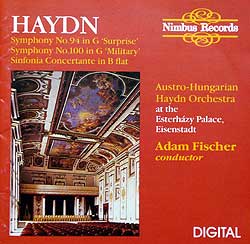 launched a digital set of complete Haydn symphonies in the late 1980s for Nimbus that sought to trump Dorati's achievement through its unique venue – the grand concert hall in Esterhŕzy Palace, where most of Haydn's works were given (and the acoustical qualities of which Haydn presumably had in mind and took into account). Although taping the London symphonies there had the virtue of consistency with Haydn's earlier work, the fact is that these works were designed to be played abroad. While Fischer intended to capture the sound of the auditorium (beautifully preserved – see the picture on the CD cover), and one would assume that its materials and dimensions would create a unique acoustical image, the differences between it and the reverberant spaces where others made their records are too slight for me to distinguish. Fischer also created an ensemble of 45, the Austro-Hungarian Haydn Orchestra, from the two countries that Eisenstadt now borders, both for purposes of becoming thoroughly immersed in the Haydn symphonic style and as a symbol of détente between former enemies. Using forces that emulate Salomon's London orchestra, Fischer achieves a lovely fundamental chamber sonority for the Military, sweetened with modern vibrato and deepened with rich bass, that projects an overall image of intimacy that, in turn, creates an especially effective contrast with the Turkish outbursts. The original CD of the Military includes the Sinfonia Concertante, featuring solo violin, cello, oboe and bassoon, also composed for the Salomon series, and can be said to comprise a thirteenth London symphony. launched a digital set of complete Haydn symphonies in the late 1980s for Nimbus that sought to trump Dorati's achievement through its unique venue – the grand concert hall in Esterhŕzy Palace, where most of Haydn's works were given (and the acoustical qualities of which Haydn presumably had in mind and took into account). Although taping the London symphonies there had the virtue of consistency with Haydn's earlier work, the fact is that these works were designed to be played abroad. While Fischer intended to capture the sound of the auditorium (beautifully preserved – see the picture on the CD cover), and one would assume that its materials and dimensions would create a unique acoustical image, the differences between it and the reverberant spaces where others made their records are too slight for me to distinguish. Fischer also created an ensemble of 45, the Austro-Hungarian Haydn Orchestra, from the two countries that Eisenstadt now borders, both for purposes of becoming thoroughly immersed in the Haydn symphonic style and as a symbol of détente between former enemies. Using forces that emulate Salomon's London orchestra, Fischer achieves a lovely fundamental chamber sonority for the Military, sweetened with modern vibrato and deepened with rich bass, that projects an overall image of intimacy that, in turn, creates an especially effective contrast with the Turkish outbursts. The original CD of the Military includes the Sinfonia Concertante, featuring solo violin, cello, oboe and bassoon, also composed for the Salomon series, and can be said to comprise a thirteenth London symphony.
Gerard Schwarz and the Scottish Chamber Orchestra (Delos, 1988)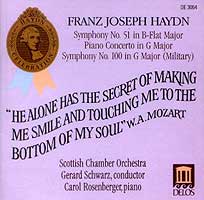 provide even more creative programming, arranging each of their CDs as a Haydn concert. Rather than the commonplace pairing of two or three of the London symphonies, their Military concludes a program comprising the much more rarely heard Symphony # 51 (boasting an unusually long and dreamy adagio with ravishing horn solos) and a Piano Concerto from Haydn's earlier career. Such a presentation, in itself, is somewhat historically authentic, as Salomon introduced each London symphony as the culmination of a variegated concert (although not only of Haydn compositions). And rather than the requisite graphic or portrait, the cover provides a delightful reminder of his influence on Mozart, one of his best friends and most ardent admirers, whose words should infuse every performance aspiring toward genuine Haydn – "He alone has the secret of making me smile and touching me to the bottom of my soul." As for the music, while the notes speak of gusto, sparkle, terrific verve and finesse, the Military rather is nicely nuanced and balanced, with the trumpet and winds blended in well (as might be expected from a conductor who played for nearly a decade as a trumpeter with the American Brass Quintet). The Turkish group is somewhat muted and integrated into the overall texture, functioning more as seasoning than astringent, and its final return is barely evident. provide even more creative programming, arranging each of their CDs as a Haydn concert. Rather than the commonplace pairing of two or three of the London symphonies, their Military concludes a program comprising the much more rarely heard Symphony # 51 (boasting an unusually long and dreamy adagio with ravishing horn solos) and a Piano Concerto from Haydn's earlier career. Such a presentation, in itself, is somewhat historically authentic, as Salomon introduced each London symphony as the culmination of a variegated concert (although not only of Haydn compositions). And rather than the requisite graphic or portrait, the cover provides a delightful reminder of his influence on Mozart, one of his best friends and most ardent admirers, whose words should infuse every performance aspiring toward genuine Haydn – "He alone has the secret of making me smile and touching me to the bottom of my soul." As for the music, while the notes speak of gusto, sparkle, terrific verve and finesse, the Military rather is nicely nuanced and balanced, with the trumpet and winds blended in well (as might be expected from a conductor who played for nearly a decade as a trumpeter with the American Brass Quintet). The Turkish group is somewhat muted and integrated into the overall texture, functioning more as seasoning than astringent, and its final return is barely evident.
Charles Mackerras,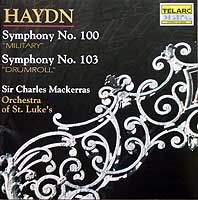 known for stripping interpretive gloss from a wide variety of music to present crisp, clean renditions, delivers a fine, vibrant, rhythmically-charged Military with the Orchestra of St. Luke's (Telarc, 1991). The attention-grabber here is the tympani that are exceptionally prominent throughout. By underlining not only the structural divisions but complementing the sharp phrasing of the opening movement, the tympani nicely anticipate the key allegretto, where focus shifts to the bass drum, played in the style of the time with palpable off-beat strokes of the small stick. The allegretto is further propelled not only by its swift pacing (4:52) but an overriding triangle that is never shy. The menuetto, too, is fleet, with the tympani marking each downbeat. known for stripping interpretive gloss from a wide variety of music to present crisp, clean renditions, delivers a fine, vibrant, rhythmically-charged Military with the Orchestra of St. Luke's (Telarc, 1991). The attention-grabber here is the tympani that are exceptionally prominent throughout. By underlining not only the structural divisions but complementing the sharp phrasing of the opening movement, the tympani nicely anticipate the key allegretto, where focus shifts to the bass drum, played in the style of the time with palpable off-beat strokes of the small stick. The allegretto is further propelled not only by its swift pacing (4:52) but an overriding triangle that is never shy. The menuetto, too, is fleet, with the tympani marking each downbeat.
Neville Marriner and the Academy of St. Martin-in-the-Fields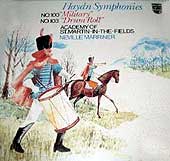 also deliver a Military with great rhythmic élan (Philips, 1976). Light and graceful, with a fine balance between strings and winds, the sharp articulation belies the moderate pacing. Beyond that, it's hard to pinpoint any particular distinctive qualities, but the mere fact that such a performance as pure music shorn of attitude is so thoroughly delightful and gratifying requires no excuse but rather speaks forcefully to the fundamental excellence of the music. also deliver a Military with great rhythmic élan (Philips, 1976). Light and graceful, with a fine balance between strings and winds, the sharp articulation belies the moderate pacing. Beyond that, it's hard to pinpoint any particular distinctive qualities, but the mere fact that such a performance as pure music shorn of attitude is so thoroughly delightful and gratifying requires no excuse but rather speaks forcefully to the fundamental excellence of the music.
Of all the conductors who bridge the gap between modern and original performance practices,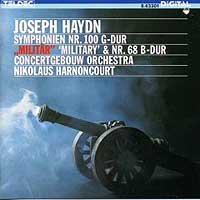 Nikolaus Harnoncourt has indisputable credentials, playing cello for 17 years in the Vienna Symphony even as he launched the Concentus musicus Wein, whose startling recordings of Bach revolutionized our view of the authentic sound of that era. His performances are often controversial but always seem challenging and fresh, as is his Military with the Concertgebouw, which provides a rich palette for his concern with the shifting textures of the work, evident from the very outset with a deeply sensitively-shaped introduction with yielding tempos and surging intensity. Beyond a general sensitivity to Haydn's orchestration, the most startling sonority comes with the Turkish music, as Harnoncourt whips the bass drum with a birch broom to add a sharp and bizarre twist to the usual impact. The notes (by Wolf-Eberhard von Lewinski) cite an 1803 critic's account of the bass drum during a Paris performance of the Military as "suspended at such a height that it could resound throughout the hall and was played mightily by a strapping bear of a man" and that as a result the janizary [Turkish] music was "unbearably loud." Harnoncourt's is one of the few recordings that really does startle even modern listeners with not only the unusual sonority but the sheer volume of the Turkish accompaniment. A second area of his fresh approach to the Military is his tweaking of the familiar uniform rhythms, by dropping a half-bar before the first movement development (no editing error here), fragmenting the fanfare into irregular phrases, and separating the sections of the menuetto by pauses and different tempi. His enterprising CD pairing is the Symphony # 68. Nikolaus Harnoncourt has indisputable credentials, playing cello for 17 years in the Vienna Symphony even as he launched the Concentus musicus Wein, whose startling recordings of Bach revolutionized our view of the authentic sound of that era. His performances are often controversial but always seem challenging and fresh, as is his Military with the Concertgebouw, which provides a rich palette for his concern with the shifting textures of the work, evident from the very outset with a deeply sensitively-shaped introduction with yielding tempos and surging intensity. Beyond a general sensitivity to Haydn's orchestration, the most startling sonority comes with the Turkish music, as Harnoncourt whips the bass drum with a birch broom to add a sharp and bizarre twist to the usual impact. The notes (by Wolf-Eberhard von Lewinski) cite an 1803 critic's account of the bass drum during a Paris performance of the Military as "suspended at such a height that it could resound throughout the hall and was played mightily by a strapping bear of a man" and that as a result the janizary [Turkish] music was "unbearably loud." Harnoncourt's is one of the few recordings that really does startle even modern listeners with not only the unusual sonority but the sheer volume of the Turkish accompaniment. A second area of his fresh approach to the Military is his tweaking of the familiar uniform rhythms, by dropping a half-bar before the first movement development (no editing error here), fragmenting the fanfare into irregular phrases, and separating the sections of the menuetto by pauses and different tempi. His enterprising CD pairing is the Symphony # 68.
 This final category uses not only the techniques but actual instruments of Haydn's time (or modern replicas). I'm considering these together not to devalue their quality or significance, but rather because they are fundamentally so similar as to preclude truly meaningful distinctions. This final category uses not only the techniques but actual instruments of Haydn's time (or modern replicas). I'm considering these together not to devalue their quality or significance, but rather because they are fundamentally so similar as to preclude truly meaningful distinctions.
- The Academy of Ancient Music, led by Christopher Hogwood (L'Oiseau-Lyre, 1984)
- The Hanover Band, directed by Roy Goodman (Nimbus, 1987)
- The Orchestra of the 18th Century, conducted by Frans Brüggen (Philips, 1992)
Each features the somewhat more nasal and distinctive sonorities of period instruments 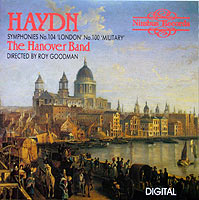 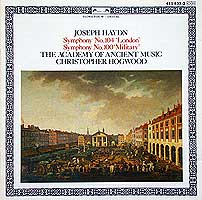 that tend to create a more crisp, airy and variegated texture than the more blended, richer orchestral sound to which we are now accustomed. While the strings are less powerful than their modern counterparts, in these particular performances they still tend to dominate the winds and brass. Hogwood uses 8 first violins, 8 second violins, 4 violas, 3 cellos and 2 basses, while Goodman shifts toward the low end with a complement of 8/6/4/5/3 and Brüggen strengthens the midrange with 9/9/6/5/3, yet the audible differences are negligible. Surprisingly, Hogwood's lighter forces and top-heavy sonic balance give slightly more prominence to his fewer strings and sounds considerably deeper than Brüggens'. All include continuo on a soft fortepiano that is barely apparent and use the prescribed small stick to sound the bass drum with clear backbeats. Among the few differences – Hogwood's tympani are more evident and he rushes headlong from the menuetto to the finale without pause; Goodman's is a bit more graceful, is set in a more reverberant acoustic (in part from the church in which his sessions were held), and attenuates the Turkish unit; and Brüggens', with more raucous percussion, has some interpretive quirks – a slower allegretto and faster menuetto and finale than the others (whose timings are nearly identical), consistently rushing the grace note in the third bar (but not the identical fifth bar) of the allegretto melody, and adding slight pauses between sections of the menuetto. Each is paired with a splendid account of the Haydn Symphony # 104 in D major ("London"), with Goodman's somewhat brisker but gentler and Hogwood's especially riveting. that tend to create a more crisp, airy and variegated texture than the more blended, richer orchestral sound to which we are now accustomed. While the strings are less powerful than their modern counterparts, in these particular performances they still tend to dominate the winds and brass. Hogwood uses 8 first violins, 8 second violins, 4 violas, 3 cellos and 2 basses, while Goodman shifts toward the low end with a complement of 8/6/4/5/3 and Brüggen strengthens the midrange with 9/9/6/5/3, yet the audible differences are negligible. Surprisingly, Hogwood's lighter forces and top-heavy sonic balance give slightly more prominence to his fewer strings and sounds considerably deeper than Brüggens'. All include continuo on a soft fortepiano that is barely apparent and use the prescribed small stick to sound the bass drum with clear backbeats. Among the few differences – Hogwood's tympani are more evident and he rushes headlong from the menuetto to the finale without pause; Goodman's is a bit more graceful, is set in a more reverberant acoustic (in part from the church in which his sessions were held), and attenuates the Turkish unit; and Brüggens', with more raucous percussion, has some interpretive quirks – a slower allegretto and faster menuetto and finale than the others (whose timings are nearly identical), consistently rushing the grace note in the third bar (but not the identical fifth bar) of the allegretto melody, and adding slight pauses between sections of the menuetto. Each is paired with a splendid account of the Haydn Symphony # 104 in D major ("London"), with Goodman's somewhat brisker but gentler and Hogwood's especially riveting.
Although I've tried to note their distinctions, every one of these two dozen recordings give a fine view of this work, and through their variety reflect the essence of Haydn. When all is said and done, perhaps the most cogent and efficient summary of the Military Symphony – and indeed of nearly all of Haydn's prodigious output – comes from Jacobson: "A lack of appreciation for Haydn is a species of inability to enjoy the good things in life."
 The year after Haydn's death in 1809, two biographies appeared. A degree of reliability is suggested by the extreme congruence of their content, but their underlying accuracy may both stem simply from being based upon similar meetings Haydn conducted in his dotage with their authors. The first was Biographische Notizen über Joseph Haydn (Biographical Notes concerning Joseph Haydn) by Georg August Greisinger (Breitkopf & Härtel, 1810). Greisinger served as an agent for Haydn's primary publishers, and his account is written as a continuous narrative with logical flow, full of biographical recollections, personal anecdotes and catalogues of the music. The second was Biographische Nachrichten von Joseph Haydn (Biographical Account of Joseph Haydn), subtitled According to his Spoken Narration, by Albert Christoph Dies (Camesina Bookshop, Vienna, 1810). Dies' largely chronological book purports to be unembellished transcriptions of thirty interviews over three years (including some when he dutifully reports that the composer was too ill to participate), and includes texts of letters and testimonials to which the author adds much flowery elaboration. Both reflect extreme respect for a dearly beloved artist, and Dies begins with a fawning dedication to Prince Esterházy. Both books comprise Joseph Haydn – 18th Century Gentleman and Genius, translated and with notes by Vernon Gotwals (University of Wisconsin, 1961). The year after Haydn's death in 1809, two biographies appeared. A degree of reliability is suggested by the extreme congruence of their content, but their underlying accuracy may both stem simply from being based upon similar meetings Haydn conducted in his dotage with their authors. The first was Biographische Notizen über Joseph Haydn (Biographical Notes concerning Joseph Haydn) by Georg August Greisinger (Breitkopf & Härtel, 1810). Greisinger served as an agent for Haydn's primary publishers, and his account is written as a continuous narrative with logical flow, full of biographical recollections, personal anecdotes and catalogues of the music. The second was Biographische Nachrichten von Joseph Haydn (Biographical Account of Joseph Haydn), subtitled According to his Spoken Narration, by Albert Christoph Dies (Camesina Bookshop, Vienna, 1810). Dies' largely chronological book purports to be unembellished transcriptions of thirty interviews over three years (including some when he dutifully reports that the composer was too ill to participate), and includes texts of letters and testimonials to which the author adds much flowery elaboration. Both reflect extreme respect for a dearly beloved artist, and Dies begins with a fawning dedication to Prince Esterházy. Both books comprise Joseph Haydn – 18th Century Gentleman and Genius, translated and with notes by Vernon Gotwals (University of Wisconsin, 1961).
Remarkably, even in light of all the further scholarly research over the past two centuries, nearly all subsequent Haydn biographies rely upon the Greisinger and Dies books uncritically and often cite them verbatim. Many tend to be unduly dry, but I can wholeheartedly recommend Karl Geiringer's highly readable Haydn – A Creative Life in Music (W. W. Norton, 1946), which both provides an account of the composer's life and traces the development of his music across many genres. Of several volumes by H.C. Robbins Landon, a student of Geiringer and the foremost Haydn scholar of all, the most relevant here is his Haydn Symphonies (BBC, 1966), a fine condensation of a lifetime of research and thinking which led to an exhaustive five-volume study. Other sources for this article are Jens Peter Larsen's New Grove Haydn (Norton, 1980), Alfred Einstein's A Short History of Music (Knopf, 1937), and notes to LPs and CDs by the following: James Lyons (Dorati LP, Mercury SR 90155; published in 1957), Bernard Jacobson (Jones LP, Checkmate C-76002; year unknown), Charles Burr (Ormandy LP, Columbia ML-5316; 1958), Karl Schumann (Klemperer LP, Angel S-36364; 1967), Irmgaard Becker-Glauch (Jochum LP set, DG 2720 064; 1975), Christopher Hogwood (his CD, L'Oiseau-Lyre 411-833; 1984), and William Malloch (Mackeras CD, Telarc 80282; 1991).

Copyright 2008 by Peter Gutmann
|


 that tend to create a more crisp, airy and variegated texture than the more blended, richer orchestral sound to which we are now accustomed. While the strings are less powerful than their modern counterparts, in these particular performances they still tend to dominate the winds and brass. Hogwood uses 8 first violins, 8 second violins, 4 violas, 3 cellos and 2 basses, while Goodman shifts toward the low end with a complement of 8/6/4/5/3 and Brüggen strengthens the midrange with 9/9/6/5/3, yet the audible differences are negligible. Surprisingly, Hogwood's lighter forces and top-heavy sonic balance give slightly more prominence to his fewer strings and sounds considerably deeper than Brüggens'. All include continuo on a soft fortepiano that is barely apparent and use the prescribed small stick to sound the bass drum with clear backbeats. Among the few differences – Hogwood's tympani are more evident and he rushes headlong from the menuetto to the finale without pause; Goodman's is a bit more graceful, is set in a more reverberant acoustic (in part from the church in which his sessions were held), and attenuates the Turkish unit; and Brüggens', with more raucous percussion, has some interpretive quirks – a slower allegretto and faster menuetto and finale than the others (whose timings are nearly identical), consistently rushing the grace note in the third bar (but not the identical fifth bar) of the allegretto melody, and adding slight pauses between sections of the menuetto. Each is paired with a splendid account of the Haydn Symphony # 104 in D major ("London"), with Goodman's somewhat brisker but gentler and Hogwood's especially riveting.
that tend to create a more crisp, airy and variegated texture than the more blended, richer orchestral sound to which we are now accustomed. While the strings are less powerful than their modern counterparts, in these particular performances they still tend to dominate the winds and brass. Hogwood uses 8 first violins, 8 second violins, 4 violas, 3 cellos and 2 basses, while Goodman shifts toward the low end with a complement of 8/6/4/5/3 and Brüggen strengthens the midrange with 9/9/6/5/3, yet the audible differences are negligible. Surprisingly, Hogwood's lighter forces and top-heavy sonic balance give slightly more prominence to his fewer strings and sounds considerably deeper than Brüggens'. All include continuo on a soft fortepiano that is barely apparent and use the prescribed small stick to sound the bass drum with clear backbeats. Among the few differences – Hogwood's tympani are more evident and he rushes headlong from the menuetto to the finale without pause; Goodman's is a bit more graceful, is set in a more reverberant acoustic (in part from the church in which his sessions were held), and attenuates the Turkish unit; and Brüggens', with more raucous percussion, has some interpretive quirks – a slower allegretto and faster menuetto and finale than the others (whose timings are nearly identical), consistently rushing the grace note in the third bar (but not the identical fifth bar) of the allegretto melody, and adding slight pauses between sections of the menuetto. Each is paired with a splendid account of the Haydn Symphony # 104 in D major ("London"), with Goodman's somewhat brisker but gentler and Hogwood's especially riveting.